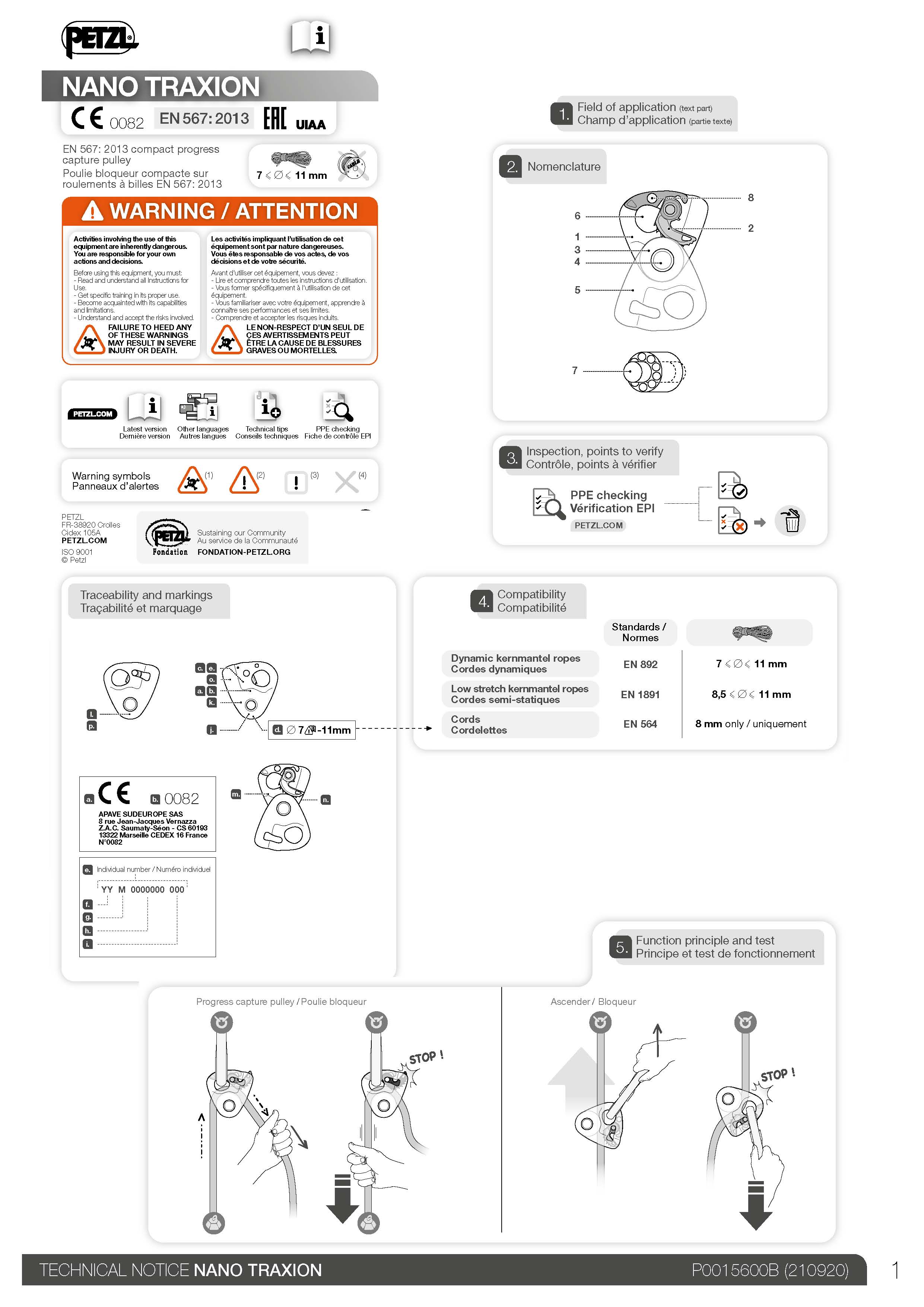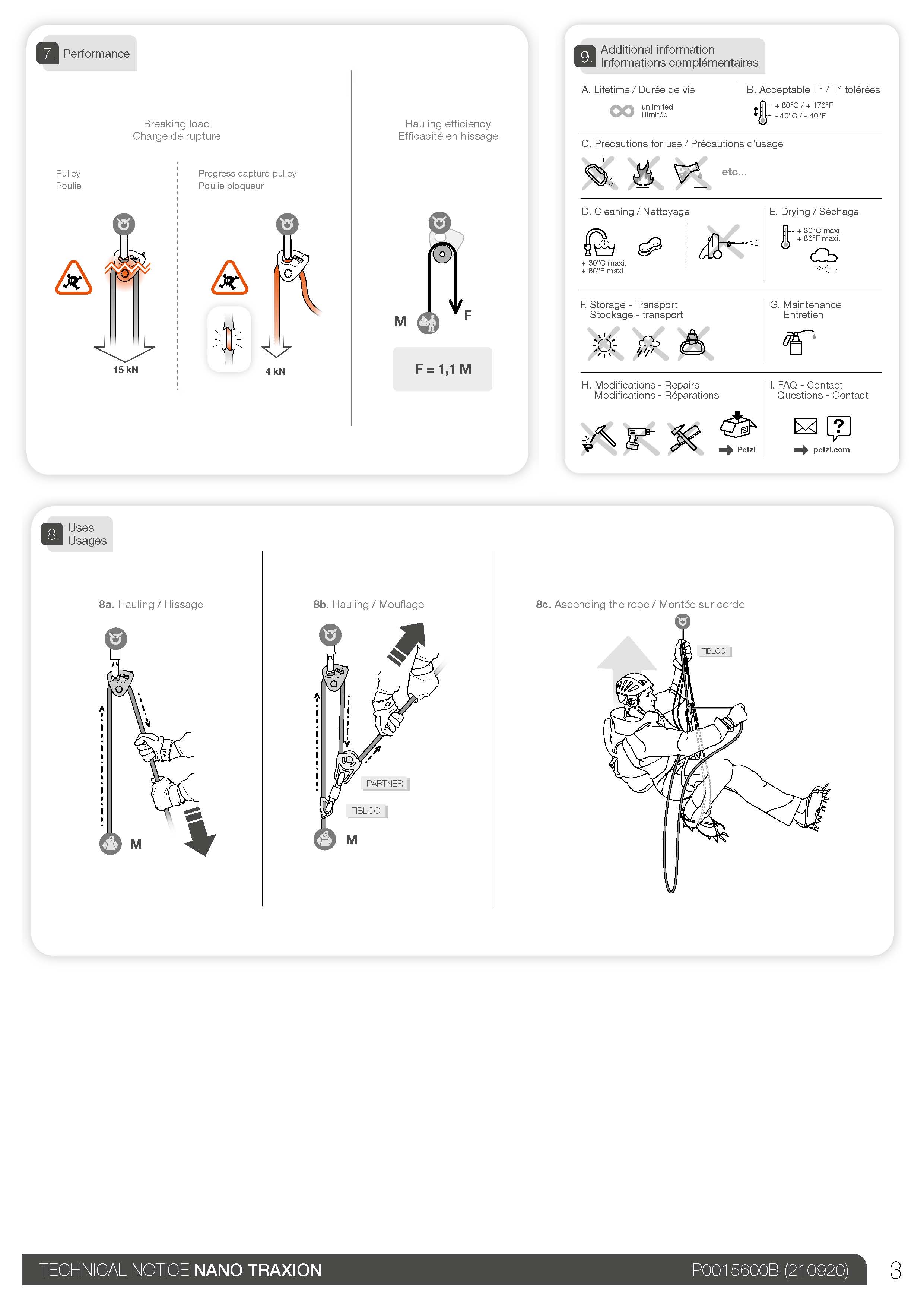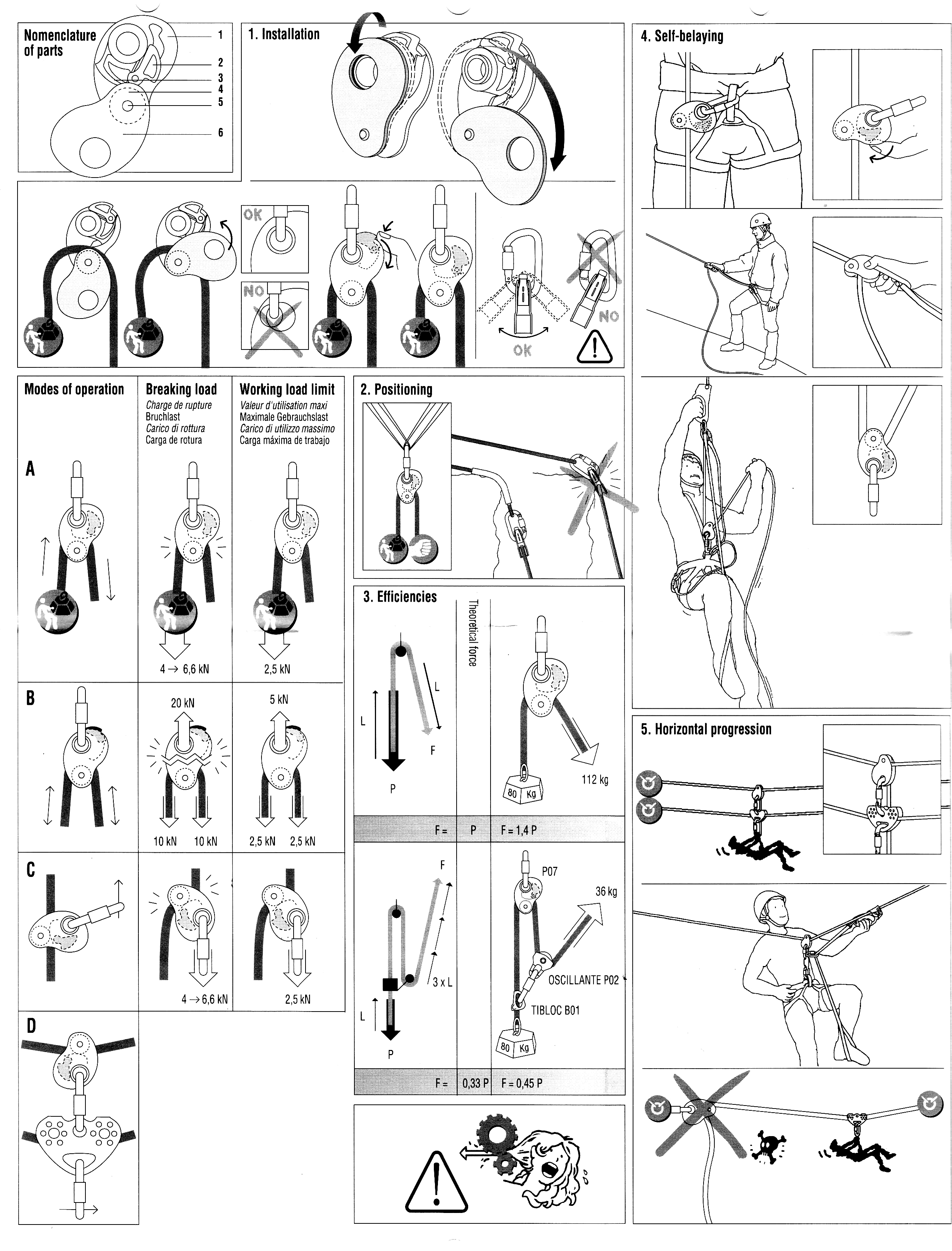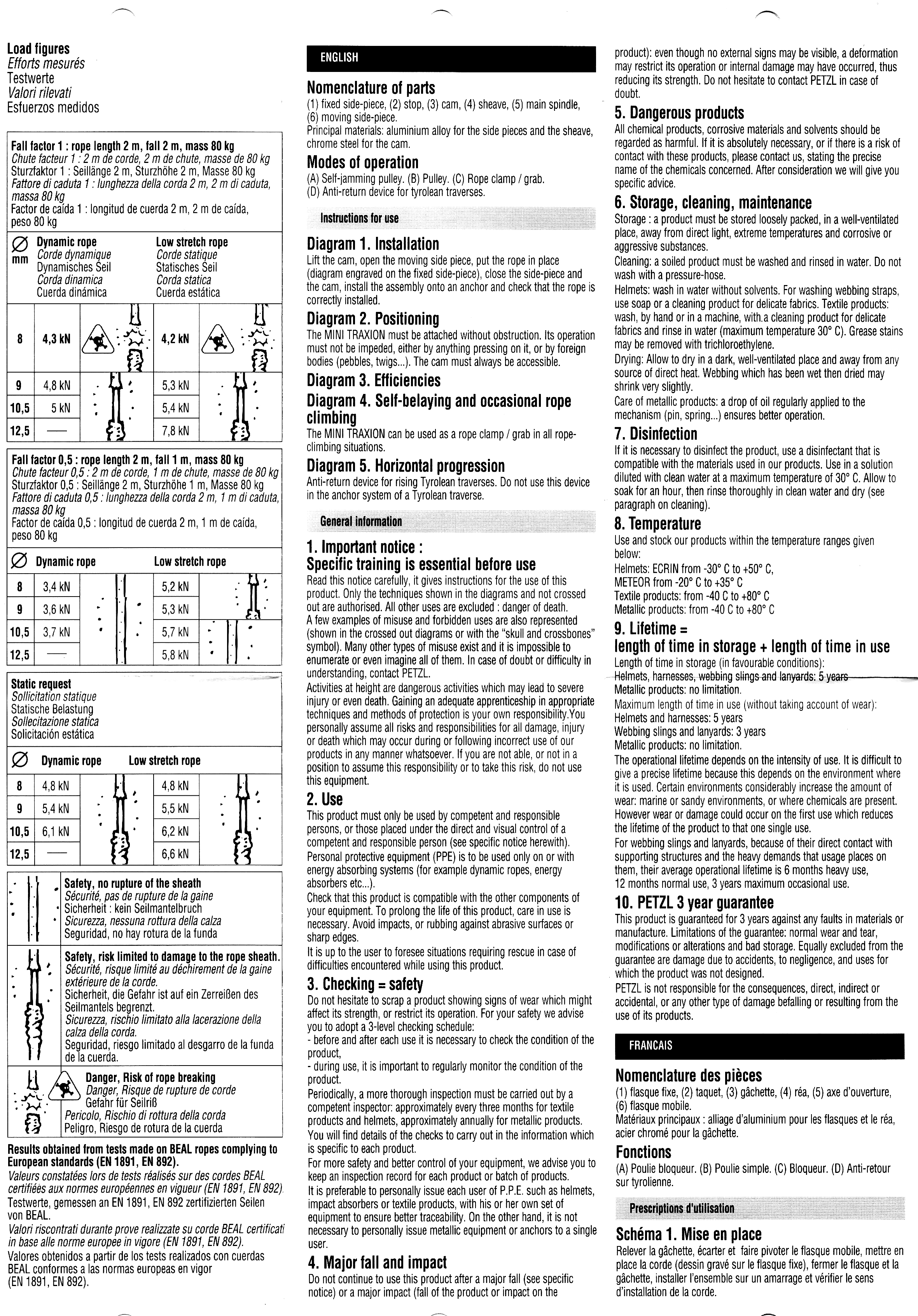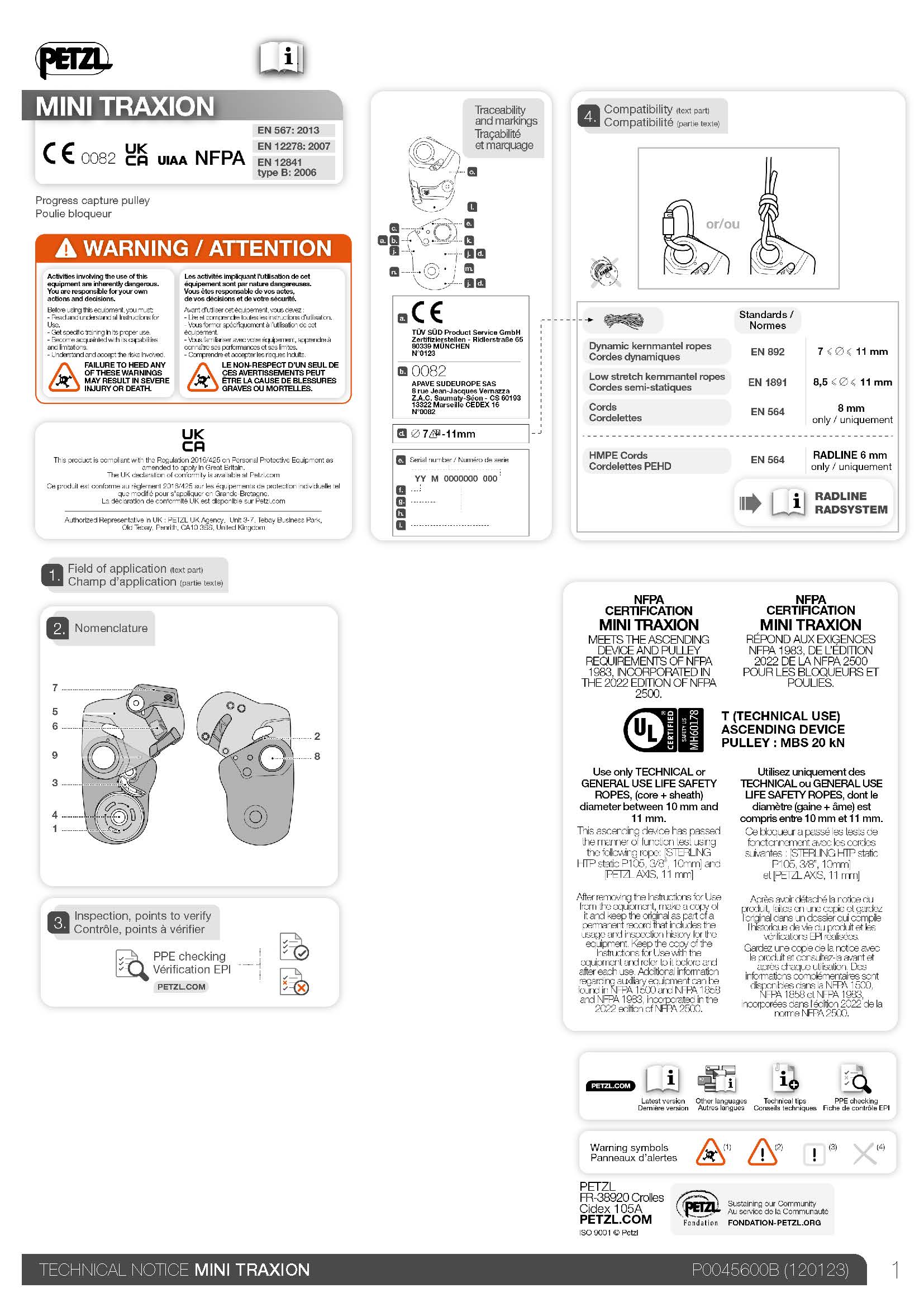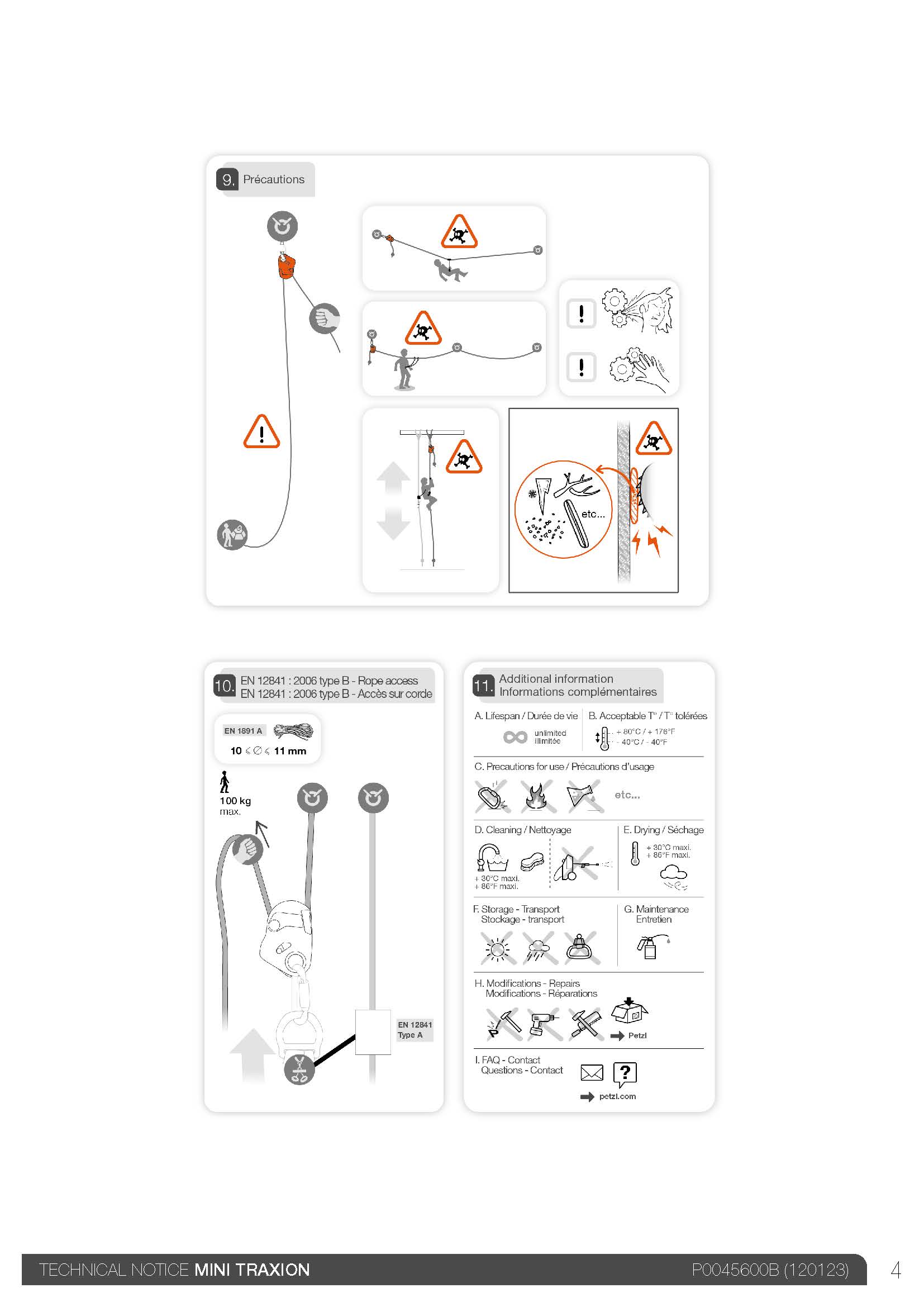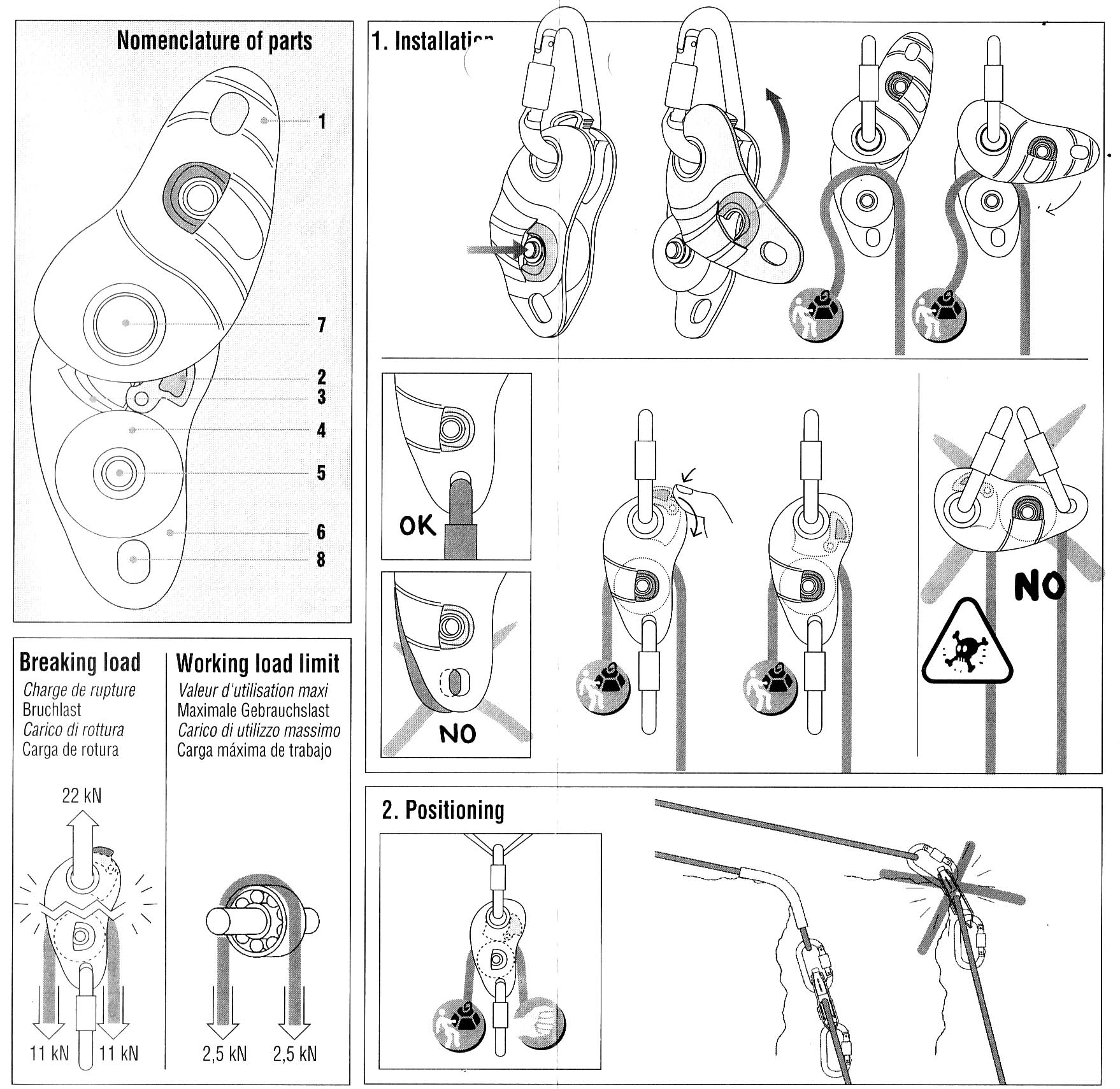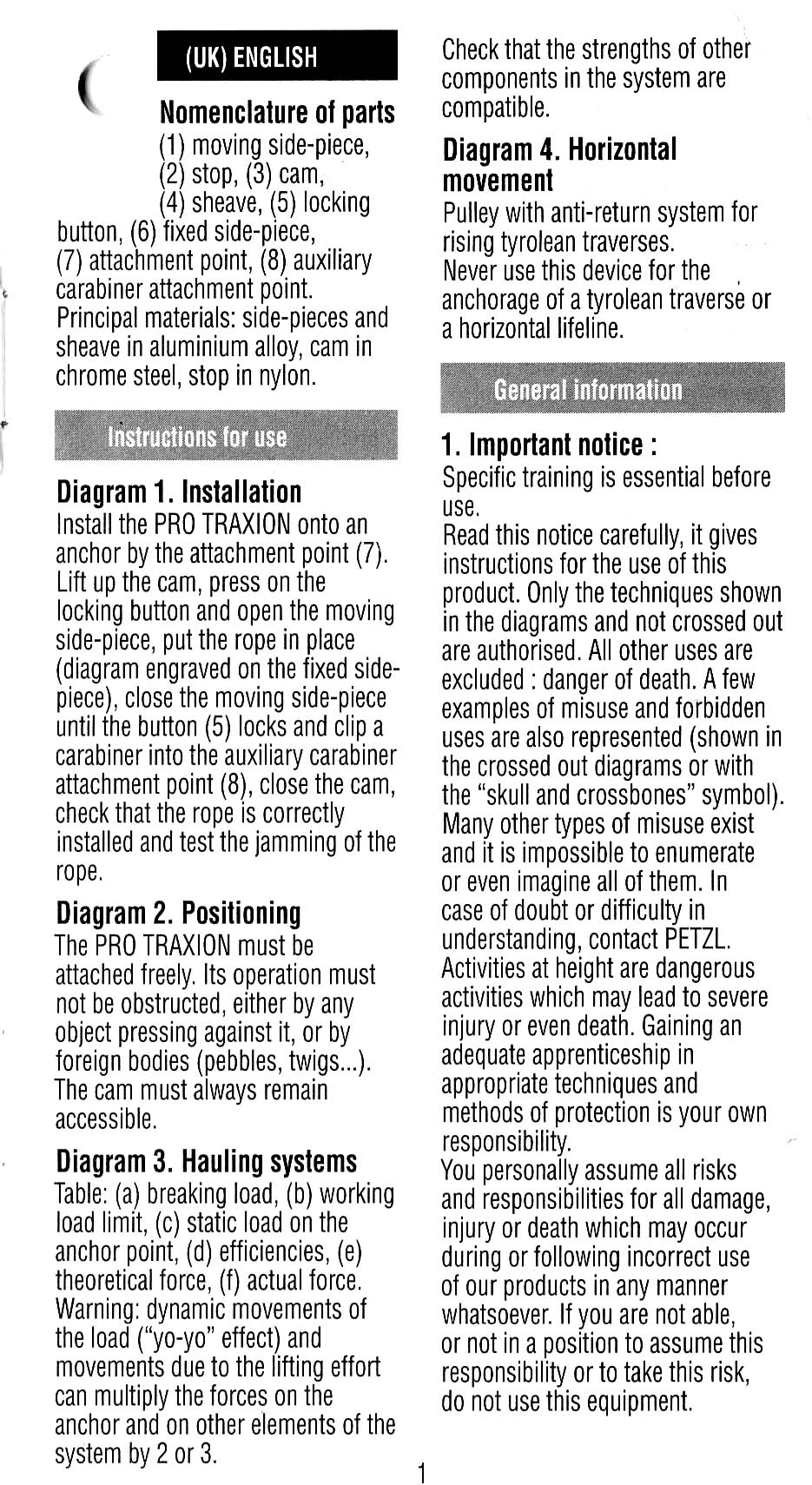Overview
[ Top
| Micro Traxion
| Mini-Traxion, Version A
| Mini-Traxion, Version B
| Pro-Traxion, Version A
| Pro-Traxion, Version A
| Wall Hauler
| Return to Hauling Pulleys
]
Nano Traxion
(#3709)
Technical Details
I acquired my Petzl Nano Traxion from CanyonZone.com - Gertjan van Pelt in 2022.
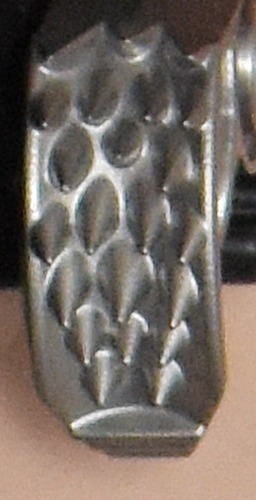 My Petzl Nano Traxion is 49 mm. tall, 53 mm. wide, 21 mm. thick, and weighs 51 g.
My Petzl Nano Traxion is 49 mm. tall, 53 mm. wide, 21 mm. thick, and weighs 51 g.
The Nano Traxion consists of a pulley and a spring-loaded toothed
cam mounted between two comma-shaped stamped 2.4 mm. aluminum
face plates. The plates are connected by a 5 mm.(?) rivet
which also serves as the pulley's axle.
The sheave is a 12.5 mm. wide unfinished aluminum turning
with an outer diameter ranging from 18 mm. in the center
to 24 mm. at the sides.
The cam is mounted on a 4.5 mm.(?) stainless steel pin. The
cam is a steel casting with a toothed eccentric cam design. The
teeth are aggressive, down-sloping teeth with a (3.4)^2(3.3.2) pattern.
The front faceplate is stamped with the
Petzl logo, two clockwise arrows, "NANO TRAXION." The rear faceplate is printed with a digital code, "21K0365891012," "PETZL FR-38920," "Crolles Cidex 105A," "CE0082", a book-with-an-"i" icon, the UIAA logo, "EN567," "Ø7", a Reading-Is-Dangerous icon, and "-11mm."
When the Nano Traxion came out, it generated tremendous interest in the roped solo climbing community. Despite this interest, this is not the kind of device that I want to depend on to take climbing falls. It was not designed for that purpose and I think it unwise to press it into such service except as a last resort.
I see the Nano Traxion more as a pulley of convenience. If you think that you might need one (and you probably won't), it is small enough that you may wish to carry it "just in case." If you are in need of a pulley for extensive, serious hauling, this is not the best choice.
[ Top
| Nano Traxion
| Mini-Traxion, Version A
| Mini-Traxion, Version B
| Pro-Traxion, Version A
| Pro-Traxion, Version A
| Wall Hauler
| Return to Hauling Pulleys
]
 Micro Traxion
Micro Traxion
(#1742)
Technical Details
I acquired my Petzl Micro Traxion from Expé-Spelemat in 2012.
My Petzl Micro Traxion is 67 mm. tall, 53 mm. wide, 24 mm. thick, and weighs 81 g.
The Mini-Traxion consists of a pulley and a spring-loaded toothed
cam mounted between two comma-shaped stamped 2.5 mm. aluminum
face plates. The plates are connected by a 5 mm.(?) rivet
which also serves as the pulley's axle.
The sheave is a 13 mm. wide unfinished aluminum turning
with an outer diameter ranging from 27 mm. in the center
to 33 mm. at the sides.
The cam is mounted on a 5 mm.(?) stainless steel pin. The
cam is a steel casting with a toothed eccentric cam design. The
teeth are aggressive, down-sloping teeth with a (3.4)^2(3.3.2) pattern. There is a spring-loaded lever mounted on a 2 mm. stainless steel pin that can engage the cam to hold it open. A plastic block protects the lever.
The front faceplate is stamped with "MICRO," "TRAXION," the
Petzl logo, "MINI Traxion," and alternating clockwise arrows and arcuate blocks. The rear faceplate is printed with a digital code, "120240R2688," "CE0082," a Reading-Is-Dangerous icon, ten dots in a circle around the pulley axle, the UIAA logo, "EN567," and "•Ø8-11mm."
The Micro Traxion is quite a nice little pulley, and seems to be more robust than the Mini-Traxion. The hold-open lever allows using the Micro Traxion as a standard pulley as well. I give it a star. 
[ Top
| Nano Traxion
| Micro Traxion
| Mini-Traxion, Version B
| Pro-Traxion, Version A
| Pro-Traxion, Version A
| Wall Hauler
| Return to Hauling Pulleys
]
 Mini-Traxion, Version A
Mini-Traxion, Version A
(#731, 2659)
Technical Details
I acquired this Petzl Mini-Traxion from Inner Mountain Outfitters in
1999. I acquired another in 2017 as part of Bob Thrun's collection.
This Petzl Mini-Traxion is 60 mm. tall, 86 mm. wide, 34 mm. thick, and weighs 173 g.
This Mini-Traxion consists of a pulley and a spring-loaded toothed
cam mounted between two comma-shaped stamped 3 mm. aluminum
face plates. The plates are connected by a 6 mm.(?) rivet
that also serves as the pulley's axle. Steel washers are placed
between the side plates and the rivet heads.
The sheave is a 19 mm. wide unfinished aluminum turning
with an outer diameter ranging from 18.8 mm. in the center
to 31.5 mm. at the sides.
The cam is mounted on a 22.2 mm.(?), 18.6 mm. I.D.
tube. The center of the tube serves as the main carabiner connecting
point. Both face plates have holes aligned with this tube. The
cam is a steel casting with a toothed eccentric cam design. The
cam angle is only about 19°, although it appears much steeper. The
teeth are aggressive, down-sloping teeth with a (3.4)(1S1)(2S1)(1S1)(2)(1s1)^2(1.2)^2
pattern where S and s are long and short mud relief slots, respectively.
The cam safety is a spring-loaded plastic piece mounted on
the base of the cam. A stainless steel pin mounted in the safety
projects into an irregular arc-shaped slot in the rear face plate.
This slot has a notch where the rod can rest to hold the cam open.
The front faceplate is stamped with "PATENTED," the
Petzl logo, "MINI Traxion," arrows showing that the
front face plate can actually open, an icon showing a body being
lifted with "4 kN" and "EN557," another icon
showing rope loads of "10 kN", a pulley force of "20
kN" and "EN12278," and finally "ROPE 8≤Ø≤13."
The rear faceplate is stamped with Petzl's Reading-Is-Dangerous icon, "CE0197,"
the UIAA logo, "MADE IN FRANCE," and the date code "9926C."
The inside of the rear faceplate has a stamped icon showing a
body being hauled into the device.
This Mini-Traxion is very light for a man-rated hauling pulley.
It looks flimsy beside the large monsters like the CMI
Uplift, RSI Rescue Hauling Pulley,
and SRT RM22 Rescuemate, but
apparently it is strong enough to pass European safety standards. The
cam teeth are aggressive, but don't seem to do any rope damage
unless one is stupid enough to rely on it to catch a dropped load.
The front faceplate is barely held closed by a tiny lip on the
cam axle; however, with a carabiner in place it can't open far.
The thumb-activated cam latch takes some getting used to. Within
60 seconds of receiving this Mini-Traxion, I managed to catch my
thumbnail on the frame, which tore the corner of the nail loose.
Still, all things considered, for it's size this Mini-Traxion
is impressive, and it deserves a star:
[ Top
| Nano Traxion
| Micro Traxion
| Mini-Traxion, Version A
| Pro-Traxion, Version A
| Pro-Traxion, Version A
| Wall Hauler
| Return to Hauling Pulleys
]
 Mini-Traxion, Version B
Mini-Traxion, Version B
(#3908)
Technical Details
I acquired this Mini-Traxion from On Rope 1 in 2023.
This Petzl Mini-Traxion is 85 mm. tall, 59 mm. wide, 28 mm. thick, and weighs 149 g.
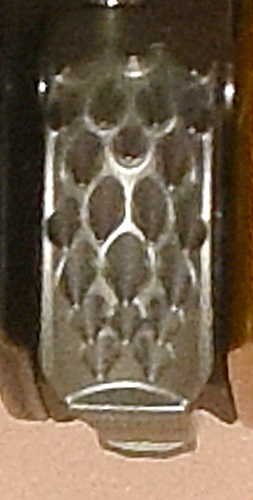 This Mini-Traxion consists of a pulley and a spring-loaded toothed
cam mounted between two stamped 3 mm. aluminum
face plates. The plates are connected by a an 18 mm. I.D.
tube that serves as the main carabiner connecting
point. It also supports a cam latch housing. A spring-loaded cast stainless steel lever can engage a nub on the cam to hold it open. Pressing the lever releases the cam.
This Mini-Traxion consists of a pulley and a spring-loaded toothed
cam mounted between two stamped 3 mm. aluminum
face plates. The plates are connected by a an 18 mm. I.D.
tube that serves as the main carabiner connecting
point. It also supports a cam latch housing. A spring-loaded cast stainless steel lever can engage a nub on the cam to hold it open. Pressing the lever releases the cam.
The cam axle is riveted to the rear plate. The
spring-loaded cam is a steel casting with a toothed eccentric cam design.The
teeth are aggressive, down-sloping teeth with a (3.4)^2(3.3.2)
pattern. The outer end of the axle has anotch that engages a steel latch on the front plate. A plastic cover hides the latch.
The sheave is a 13 mm. wide unfinished aluminum turning
with an outer diameter ranging from 32.0 mm. in the center
of a cirvcumferential U-shaped rope groove to 37.4 mm. at the sides. The bearing provides smooth operation.
The front faceplate is printed with the Petzl lofo and "MINI-TRAXION." The rear plate is printed with "23H0506834688," an IQR code, "Patented," the UIAA logo, a book-with-an-"i" icon, "CE0082, the UKCA logo, an icon
showing rope loads of "2.5 kN" and pulley limits of "MBS 20 kN" and "WLL 5 kN," "EN12841:2006 B," "Max 100 kg," "•Ø 10-11mm,""EN567:2013," "Ø 7(followed by a read9ing-is-dangerous icon)-11mm," "EN12278:2078," "Ø 7(followed by a read9ing-is-dangerous icon)-11mm," the UL logo, "PETZL", "FR-38920," "Crolles", "Cidex 105A," "NFPA 2500 (1983), 2022 ED.", Rope Grab (T): Ø 10-11mm," and "Pulley (T): Ø 10-11mm."
In pristine conditions, this version is superior to the original. The opening latch takes some getting used to, but at least I didn'y tear a nail with this one. Top open this Mini-Traxion, slide the plastic cover down with hour thumb, then slide the thumb onto the inner steel latch and push it upwards. Practice until it feels natural.
Because of the small, close-fitting parts in the cam latch and the cover latch so I would not recommend this version for use in heavy mud conditions.
The maximum mass ("Max 100kg") printed on the rear platecan easily be less than the mass of a fully loaded caver. Although I know what this means, American courts may not, so I cannot recommend this ascender for heavier cavers or for expedition caving. Foreign manufacturers may not understand that American courts might interpret "100 kg." as an advertised safe working limit, even if that is not the intent (its not even a force).
|
 |
Warning:
The weight ("100kg") printed on the handle can easily be
less than the weight of a fully loaded caver. |
 |
|
[ Top
| Nano Traxion
| Micro Traxion
| Mini-Traxion, Version A
| Mini-Traxion, Version B
| Pro-Traxion, Version A
| Wall Hauler
| Return to Hauling Pulleys
]
Pro-Traxion, Version A
(#758)
Technical Details
I acquired this Petzl Pro-Traxion from Inner Mountain Outfitters
in 2001.
This Petzl Pro-Traxion is 126 mm. tall, 66 mm
wide, and 36 mm. thick. Mine weighs 288 g.
This Pro-Traxion consists of a pulley and a spring-loaded toothed
cam mounted between two stamped 3 mm. aluminum
face plates. The plates are connected by a an 18 mm. I.D.
tube that serves as the main carabiner connecting
point and as the cam axle. The front faceplate pivots on the cam axle. A spring-loaded plunger on the pulley axle holds the front faceplate closed. This method provides more security than the Mini-Traxion Version A's approach. The pulley is larger: 38.3 mm. center O.D., 47.6 mm. side O.D.
The front faceplate is stamped with the
Petzl logo, "PRO TRAXION," "ROPE
•," an illustration of a person with an arrow curving upward, and an illustration of a hand pulling an bent arrow.
The rear faceplate is stamped with Petzl's
Reading-Is-Dangerous icon; "MADE IN FRANCE;" "PATENTED;" a free pulley rigging illustration with the total load vector labeled "kN 22," each rope load vectors labeled "1 kN," and the illustration labeled
EN12278; a hauling pulley illustration with a human load labeled 4kN and the illustration labeled "
EN567;" the UIAA logo; and "CE0197." The inside of the rear plate is stamped with an illustration of a person with an arrow curving upward.
Although the Pro-Traxion has several improvements over the
Mini-Traxion, I'm not sure that it is worth the extra size and
weight. On the other hand, compared to the CMI
Uplift, RSI Rescue Hauling Pulley,
and SRT RM22 Rescuemate, it is
positively tiny and nearly weightless. It is lighter and smaller
than the Ushba Mountain Works Hogwauler, which
I consider to be the closest contender.
[ Top
| Nano Traxion
| Micro Traxion
| Mini-Traxion, Version A
| Mini-Traxion, Version B
| Pro-Traxion, Version A
| Wall Hauler
| Return to Hauling Pulleys
]
Pro-Traxion, Version B
(#1822)
Technical Details
I acquired my Petzl Pro-Traxion, Version B from On Rope 1 at the 2014 NSS Convention.
This Pro-Traxion, Version B is 118 mm. tall, 70 mm. wide, 35 mm. thick, and weighs 260 g.
The faceplates are stamped from aluminum alloy. The cam is mounted on an 18 mm. I.D.
tube. The center of the tube serves as the main carabiner connecting
point. Both face plates have holes aligned with this tube, and the front plate pivots on this tube. The front plate supports a latch assembly consisting of a plastic housing, a yellow plastic release lever with red paint to indicate when it is not latched, a black plastic catch, and an internal spring.
There is a small (14 mm. by 14 mm.)
carabiner hole below the pulley. Some carabiners may not fit in this
hole.
The pulley is 14.8 mm. wide and 46.6 mm. in diameter. It has a 13.5 mm. U-shaped groove with a 38 mm. minor diameter. The I.D. of the pulley is 27.7 mm., allowing room for a bearing assembly. This rides on an 18 mm. axle.
The cam is mounted on a 5 mm.(?) stainless steel pin. The
cam is a steel casting with a toothed eccentric cam design. The
teeth are aggressive, down-sloping teeth with a (2.3.4)(1S1.2S2)^2(1S1)(2.1) where the "S" indicates a single central slot. There is a spring-loaded lever mounted on a 2 mm. stainless steel pin that can engage the cam to hold it open. A plastic block protects the lever and the tube connecting the plates.
The front faceplate is stamped with "PRO," "TRAXION," the
Petzl logo, and a Reading-Is-Dangerous icon. The front of the latch housing has the Petzl logo. The rear faceplate is printed with a digital code, "13332D6101," "Made in France," "Patent Pending," "CE0082," "EN567," "•Ø8-13mm," the Underwriters Laboratory "Classified" logo, "ASCENDER: tested to 5 kN Ø11-13mm," PULLEY: MBS 22 kN Ø11-13mm," "T(TECHNICAL USE)," and >Meets NFPA 1983 (2012 ED.)."
This version is significantly more compact than its predecessor.
The latch mechanism is effective, although it appears to be susceptible to fouling in muddy conditions.
The markings indicate that it is suitable for 8 to 11 mm. ropes, but the test certification only applies to 11 toe 13 mm. ropes. Keep this in mind.
The cam teeth are sharp, so watch your fingers.
[ Top
| Nano Traxion
| Micro Traxion
| Mini-Traxion, Version A
| Mini-Traxion, Version B
| Pro-Traxion, Version A
| Pro-Traxion, Version A
| Return to Hauling Pulleys
]
 Wall Hauler
Wall Hauler
(#666, 2663)
Technical Details
I acquired my Petzl Wall Hauler from
Sean Stewart in 2009. I acquired another in 2017 as part of Bob Thrun's collection.
The Petzl Wall Hauler is 154 mm
tall, 66 mm. wide, and 50 mm. thick. Mine weighs 233 g. The Wall Hauler is a small pulley with an eccentric
cam mounted on a suspended frame. The spring-loaded steel cam
has 11 rows of chisel-shaped teeth. The pin can be used to keep
the cam from opening enough to free the rope, or to hold the cam
completely open.
The front of the Wall Hauler is printed with "wall hauler," the "Reading is Dangerous" icon, the Petzl logo, a down-pointing arrow, a weight icon, an icon of a person inside a circle-and-slash, and "1 kN." The rear plate is stamped '990011L."
The Wall Hauler was designed for hauling haul bags on big wall
climbs. I've found that it works very well for that purpose -
the improvement over the traditional Jumar haul more than justifies
carrying the additional weight. It is also a great device for
hauling SCUBA tanks out of cenotes. The wall hauler is designed
for light loads.
|
 |
Warning:
The
Wall Hauler should never be used to support human loads. |
 |
|
The Wall Hauler was originally designed and made by Rock Exotica.
[ Top
| Nano Traxion
| Micro Traxion
| Mini-Traxion, Version A
| Mini-Traxion, Version B
| Pro-Traxion, Version A
| Pro-Traxion, Version A
| Wall Hauler
]



